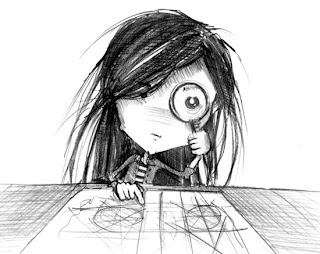"Actual happiness
always looks pretty squalid in comparison with the over-compensations for
misery."
Aldous Huxley "Brave New World"
"Faktyczna szczęśliwość zawsze wypada blado na tle spodziewanej nagrody za nędzę"
Aldous Huxley "Nowy Wspaniały Świat"
"How did you draw the sketch?" - that's the question I was asked several times when I tried to explain "step by step" how my illustrations were created. Already made sketch was usually the first step. So now I decided to present as precisely as possible how it's actually drawn. I just have to warn you that it's not a lesson about perspective (obviously one post wouldn't be enough for that).
0. A concept
sketch made with just any pen on an accidentally found piece of paper. For me
it's quite accurate and readable... but possibly only for me. And
here's the relevant drawing:
0. Szkic koncepcyjny zrobiony na przypadkowo znalezionym
skrawku papieru byle jakim pisakiem. Dla mnie jest on całkiem dokładny i w
pełni czytelny, ale możliwe, że tylko dla mnie. A teraz rysunek właściwy:
1. Just a
few lines but they determine what will be displayed in the frame and define placement
of vanishing points. At the beginning of drawing I use a very tired pen approaching
to the end of its way to the dustbin. However it still leaves delicate lines on
paper.
1.To zaledwie kilka kresek, ale pokazują one , co właściwie
zmieści się w kadrze oraz określają, gdzie mniej więcej znajdują się punkty
zbiegu. Na początku używam bardzo wysłużonego cienkopisu, który zbliża się już do kresu
swojej drogi na śmietnik, jednak zostawia jeszcze bardzo delikatne ślady na
papierze.
2. Basic
divisions of the block and general draft of most significant elements. At this
stage lots of elements can be inadequate so it's better to draw poorly visible
lines.
2. Podstawowe podziały bryły i ogólny zarys ważniejszych
elementów. Na tym etapie sporo elementów może być "nietrafionych",
więc bezpieczniej jest rysować ledwo
dostrzegalnymi liniami.
3. Finally
it's time for brand new pen! We emphasize what's important in our previous
sketch and ignore guide lines and marks drawn not where they are needed. By the
way we add further divisions. To be honest that's probably the most challenging
stage.
3. Wreszcie pora na nowiutki cienkopis! Wydobywamy to, co
jest istotne w dotychczasowym szkicu ignorując pomocnicze linie konstrukcyjne i
kreski postawione w nieodpowiednich miejscach. Przy okazji dodajemy kolejne
podziały. Prawdę mówiąc to chyba najbardziej wymagający etap.
4. Drawing
outlines of ornaments. Watching lots of references before that can be really
helpful.
4. Zarysy ornamentów. Dobrze jest zapoznać się wcześniej z
wieloma przykładami ornamentów.
5. Further
detailing.
5. Dalsze zagłębianie się w detale.
6. Materials,
textures and ... oh ... plants.
6. Materiały, faktury i... o... roślinki.









No comments:
Post a Comment